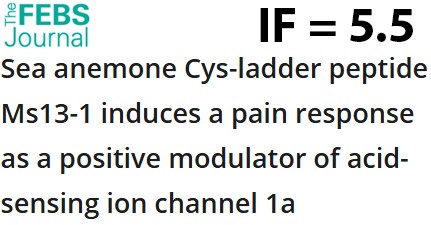Press-room / news / Science news /
FEBS Journal Editor’s choice: the research article about peptide modulator of ASIC1a with a unique structure
Researchers from Laboratory of Neuroreceptors and Neuroregulators and Laboratory of Biomolecular NMR-Spectroscopy of IBCh RAS, together with the Laboratory of Biological Testing of the BIBCh, isolated and characterized Ms13-1, a new peptide of the sea anemone Metridium senile with a unique 3D-structure and a pronounced selective effect on acid-sensing ion channels ASIC1a. Ms13-1 has a spatial fold named the "Cys-ladder" by the authors, and is a member of a novel structural class. In the nanomolar range, Ms 13-1 acts as a positive allosteric modulator of ASIC1a, and the injection of the peptide into the mouse hind paw causes pain, which is suppressed by the selective antagonist of ASIC1. The work was published in the FEBS Journal and was marked as the Editors' choice for the May issue.
It is known that some animals produce venomous secretions, which contain a wide variety of peptide molecules (toxins). An important target of these peptides are neuronal ion channels, which are involved in the generation and transmission of pain. Among them are the natural proton sensors – ASIC channels, which are abundantly represented in the peripheral nervous system of mammals. However, while the ASIC1b and ASIC3 isoforms have been reliably shown to be associated with pain of various modalities, the involvement of the ASIC1a isoform in these processes has remained poorly understood.
As part of the work, the ectodermal secretion of the sea anemone Metridium senile was analyzed. A peptide component named Ms13-1 was found in it, which selectively enhanced the activation of homomeric ASIC1a. Ms13-1 did not activate ASIC1a directly, but enhanced ion currents mediated by it by up to 50% in response to acidic stimuli in the pH range from 6.9 to 5.5 (EC50 = 68 nM at pH 5.5). It was noted that Ms13-1 did not alter the channel's affinity for proton binding, which indicates that its action occurs by an allosteric mechanism.
By its primary structure, Ms13-1 has no homolog among known peptides. Also, the analysis of the spatial structure using NMR spectroscopy showed that the peptide has a unique type of folding. Ms13-1 adopts a three-dimensional structure in the form of an antiparallel β-sheet consisting of three strands and an extended C-terminal part of the peptide, which is "sewn" to the β-sheet by three disulfide bonds. An additional fourth disulfide bond stabilizes the first two β-strands. This type of folding was named by the authors "cystine ladder" (“Cys-ladder”) by visual analogy.
In experiments on mice, the injection of Ms13-1 into the hind paw caused a pronounced prolonged pain reaction. This effect was significantly suppressed with the combined administration of Ms 13-1 and the selective ASIC1 blocker mambalgin-2, which indicates the direct effect of Ms13-1 on ASIC1a channels in vivo. Therefore, Ms 13-1 can serve as a valuable tool for studying pain signaling pathways involving ASIC1a channels. Its ability to enhance the action of ASIC1a activators present in the extracellular environment can be used as a new tool for identifying and characterizing trace amounts of endogenous ASIC1a activators.
The work was done on the basis of the Laboratory of Neuroreceptors and Neuroregulators of IBCh RAS, the spatial structure analysis was performed by K.S. Mineev (Laboratory of Biomolecular NMR-Spectroscopy), and experiments on mice were performed in the Laboratory of Biological Testing of the IBCh RAS. The results are published in the FEBS Journal and marked as the Editors' choice for the May issue of the journal.
may 29


